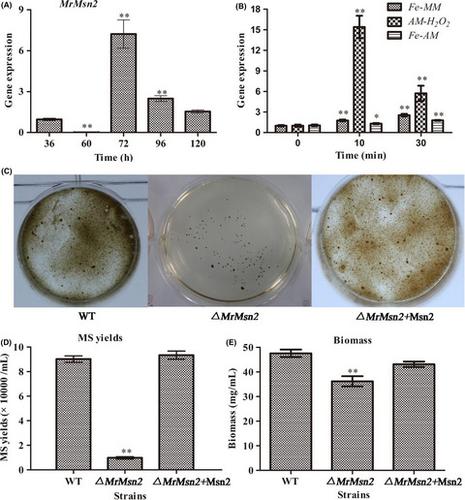当前位置:
X-MOL 学术
›
Microb. Biotechnol.
›
论文详情
Our official English website, www.x-mol.net, welcomes your
feedback! (Note: you will need to create a separate account there.)
A transcription factor, MrMsn2, in the dimorphic fungus Metarhizium rileyi is essential for dimorphism transition, aggravated pigmentation, conidiation and microsclerotia formation
Microbial Biotechnology ( IF 4.8 ) Pub Date : 2018-08-29 , DOI: 10.1111/1751-7915.13302
Zhangyong Song 1 , Jie Yang 1 , Caiyan Xin 1 , Xiaorui Xing 1 , Qing Yuan 1 , Youping Yin 2 , Zhongkang Wang 2
Microbial Biotechnology ( IF 4.8 ) Pub Date : 2018-08-29 , DOI: 10.1111/1751-7915.13302
Zhangyong Song 1 , Jie Yang 1 , Caiyan Xin 1 , Xiaorui Xing 1 , Qing Yuan 1 , Youping Yin 2 , Zhongkang Wang 2
Affiliation

|
Microsclerotia (MS) are pseudoparenchymatous aggregations of hyphae of fungi that can be induced in liquid culture for biocontrol applications. Previously, we determined that the high‐osmolarity glycerol (HOG) signalling pathway was involved in regulating MS development in the dimorphic insect pathogen Metarhizium rileyi. To further investigate the mechanisms by which the signalling pathway is regulated, we characterized the transcriptional factor MrMsn2, a homologue of the yeast C2H2 transcriptional factor Msn2, which is predicted to function downstream of the HOG pathway in M. rileyi. Compared with wild‐type and complemented strains, disruption of MrMsn2 increased the yeast‐to‐hypha transition rate, enhanced conidiation capacity and aggravated pigmentation in M. rileyi. The ▵MrMsn2 mutants were sensitive to stress, produced morphologically abnormal clones and had significantly reduced MS formation and decreased virulence levels. Digital expression profiling revealed that genes involved in antioxidation, pigment biosynthesis and ion transport and storage were regulated by MrMsn2 during conidia and MS development. Taken together, our findings confirm that MrMsn2 controlled the yeast‐to‐hypha transition, conidia and MS formation, and virulence.
中文翻译:

二形性真菌莱氏绿僵菌中的转录因子 MrMsn2 对于二形性转变、色素沉着加剧、分生孢子形成和微菌核形成至关重要
微菌核(MS)是真菌菌丝的假薄壁组织聚集体,可以在液体培养物中诱导用于生物防治应用。此前,我们确定高渗透甘油(HOG)信号通路参与调节二态性昆虫病原体莱氏绿僵菌的 MS 发育。为了进一步研究信号通路的调节机制,我们对转录因子 MrMsn2 进行了表征,它是酵母 C 2 H 2转录因子Msn2 的同源物,预计其在M. rileyi中的 HOG 通路下游发挥作用。与野生型和互补菌株相比,MrMsn2的破坏增加了莱氏酵母中酵母菌向菌丝的转化率,增强了分生孢子形成能力并加剧了色素沉着。▵MrMsn2突变体对应激敏感,产生形态异常的克隆,并显着减少 MS 形成并降低毒力水平。数字表达谱显示,在分生孢子和 MS 发育过程中,参与抗氧化、色素生物合成以及离子运输和储存的基因受到MrMsn2的调节。综上所述,我们的研究结果证实,MrMsn2 控制酵母菌向菌丝的转变、分生孢子和 MS 的形成以及毒力。
更新日期:2018-08-29
中文翻译:

二形性真菌莱氏绿僵菌中的转录因子 MrMsn2 对于二形性转变、色素沉着加剧、分生孢子形成和微菌核形成至关重要
微菌核(MS)是真菌菌丝的假薄壁组织聚集体,可以在液体培养物中诱导用于生物防治应用。此前,我们确定高渗透甘油(HOG)信号通路参与调节二态性昆虫病原体莱氏绿僵菌的 MS 发育。为了进一步研究信号通路的调节机制,我们对转录因子 MrMsn2 进行了表征,它是酵母 C 2 H 2转录因子Msn2 的同源物,预计其在M. rileyi中的 HOG 通路下游发挥作用。与野生型和互补菌株相比,MrMsn2的破坏增加了莱氏酵母中酵母菌向菌丝的转化率,增强了分生孢子形成能力并加剧了色素沉着。▵MrMsn2突变体对应激敏感,产生形态异常的克隆,并显着减少 MS 形成并降低毒力水平。数字表达谱显示,在分生孢子和 MS 发育过程中,参与抗氧化、色素生物合成以及离子运输和储存的基因受到MrMsn2的调节。综上所述,我们的研究结果证实,MrMsn2 控制酵母菌向菌丝的转变、分生孢子和 MS 的形成以及毒力。




































 京公网安备 11010802027423号
京公网安备 11010802027423号